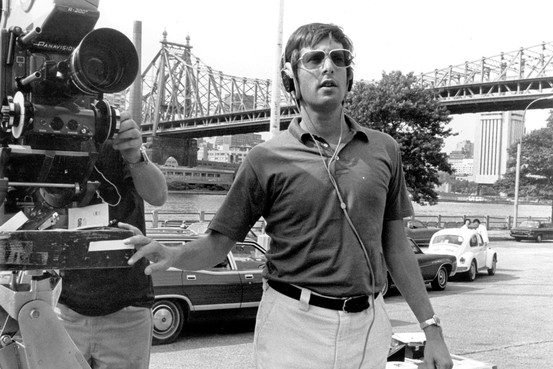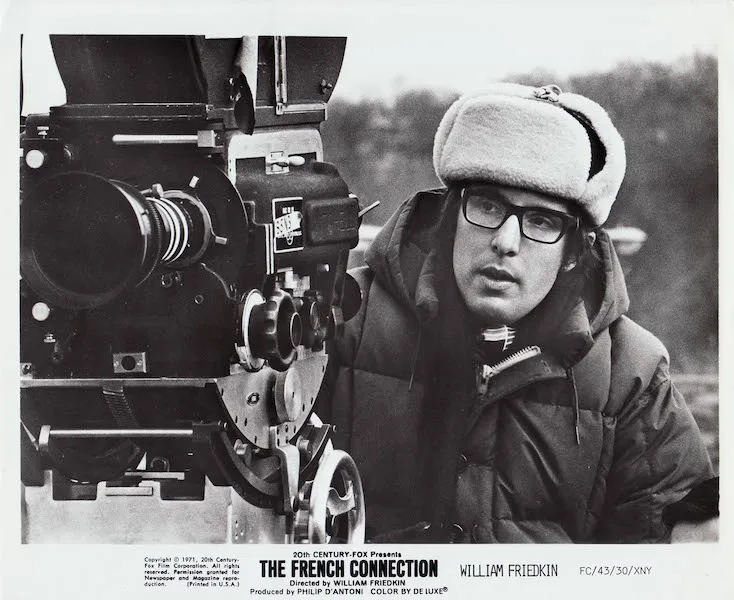Boy does it hurt to admit William Friedkin was mortal after all. It didn’t seem like he’d ever die; he was so demonstrably in love with life, his art, and the engagement of living an artistic existence, it seemed impossible his flame could be extinguished. Of course, now it will burn more brightly, and forever. As such, it doesn’t seem appropriate feeling sad about an 87-year-old who did every single thing he was put here to do, officially passing the torch to subsequent generations (the best of whom, he certainly knew, could never begin to touch his best work). It’s also gratifying that he stuck around long enough to see his baby, the maligned and confounding Sorcerer, receive an overdue reappraisal (one he took a large part in orchestrating, to his credit). More on that shortly.
Let’s begin with the obvious: he directed The French Connection and The Exorcist. These belong on any short list of all-time great movies and signify possibly the best one-two punch in cinema. All his best films can be broken down not just scene by scene, but second by second, savored and studied, and fully enjoyed—which was his primary purpose, of course, as any of the wonderfully entertaining and refreshing interviews he did make abundantly clear. He was an authentic badass, and one of the singular cultural icons America has produced.
He didn’t just accept challenges, he created problems only he could solve, and was preoccupied with overcoming obstacles—artistic and otherwise—that he put in his own path. This was not necessarily self-destructive or egotistical; Friedkin simply refused to acknowledge he could not bend reality to his indefatigable will, and if he abandoned some friends, colleagues, and spouses on the side of the road, he also left most of his competition there as well.
Picture this: a perilous bridge must be navigated in the most dangerous conceivable conditions. Improbably, it is successfully crossed and then washes away, no retreat possible—even if one is desired or necessitated. This is the central metaphor not only for Sorcerer—the misunderstood and, arguably, mistitled movie Friedkin considered his masterwork—but the director’s career. Burned or blown out bridges driven, walked, or crawled over, under duress, the only outcome death or glory.
If you’re uncharitable or myopic, you could add up the films and conclude that Friedkin’s failures outnumbered his successes. But those victories were so enormous, so untouchably brilliant, so sui generis, they not only overwhelm his oeuvre, but claim considerable oxygen in the annals of American cinema. He could have retired in 1974 and his legacy would have been secured.
Exhibit A: He filmed an impossible chase scene, sans studio trickery, and in the first of many audacious, alpha dog moves, no permits—immortalizing the filthy and claustrophobic streets of Brooklyn. And not for nothing, he was in that car holding the camera as it blasted its way into cinematic and cultural history.
Exhibit B: More than a decade later, he doubled down and recorded an arguably more complicated and dangerous scene, a complex and high-speed affair that climaxes with a lone car on the vast L.A. freeway racing against rush hour traffic. Suffice it to say, the time, choreography, creativity, stubbornness, sense of adventure, disdain for budgetary or logistical constraints, and mostly the set of balls this required are so off the charts there’s not a comparable case study.
A few additional thoughts: both these scenes, while absolute technical triumphs, are not stylistic indulgences: they serve to establish, beyond any doubt, that the character in question (Gene Hackman’s Popeye Doyle in The French Connection and William Peterson’s Richard Chance in To Live and Die in L.A.—both doing career-best work) is obsessed and more than willing to die. One is in pursuit, the other being pursued, but they’re each pushed way beyond sane or legal boundaries. Best of all, they wouldn’t have it any other way.
Art imitates life, and vice versa. You watch (or, if you’re among the converted, re-watch) these scenes and marvel that the buck stopped with the one man willing, and crazy enough to pull them off. These aren’t two of the best chase scenes in history, they are the two best (of course Bullitt, The Seven-Ups and, for my money, the motorcycle chase from The Terminator and the visual opera of The Road Warrior’s final convoy are all part of the conversation). Speaking of Bullitt, let’s offer substantial props to stunt driver Bill Hickman (who also plays a small role in The French Connection): he helped drive the cars and choreograph the chaos.
Friedkin being Friedkin, it only makes sense that the most harrowing footage he ever shot did not involve cars crashing or possessed girls puking, but was practically a scene shot in slow motion. This would, naturally, be the infamous “bridge scene” in Sorcerer, another all-analog affair created by real people in real time with comparatively primitive equipment. It’s a rare instance where, even though you know it’s a movie (which means it’s make believe and no one actually died) you still shiver, in awe and not a little frightened about what you’re witnessing. (If it’s not yet abundantly clear, reading about the behind-the-scenes shenanigans and setbacks Friedkin instigated and endured over the years is almost as interesting as the films themselves.)
In addition to advancing the plot and ratcheting up the intensity, Friedkin went to such extremes for the same reasons Werner Herzog forced his crew to move a boat over a mountain: because he could, because he had to. Taken in this context, it makes perfect sense that Friedkin maintained, until the end, that Sorcerer was the film he was most proud of; that it was his best work. And therein lies the rub: Friedkin continued making movies, not many of them measuring up to the standard he set in the ‘70s. How could they?
Still, special mention must be made of Cruising, a film that sort of occupies its own space, not only within Friedkin’s filmography, but in artistic and cultural history. It warrants attention in part because it’s difficult to find two people who feel the same way about it for the same reasons. Is it merely a mediocre mess, drowned in its own confused ambition, or is it an ill-fated, misunderstood, miscast near-miss masterpiece? Yes. And that scarcely scratches the surface. With the benefit of hindsight, we can—and should—appreciate Cruising for being a pitch perfect, if exceedingly ugly, time capsule of pre-AIDS America. It’s also a capstone of sorts for an unofficial project—which arguably commenced with Friedkin (The French Connection), then included Lumet (Serpico and Dog Day Afternoon) and Scorsese (Taxi Driver)—depicting The Big Apple in its grimy, authentic, utterly ‘70s splendor. It seems appropriate that, of all the controversial movies ever made, Cruising defies being a love-or-hate affair, and invites, even necessitates, all the shades of gray. For instance, one can appreciate the aforementioned vistas of a long-gone NYC (and, in particular, the way Friedkin captures the dark rot of alleys or apartment stairwells and dorm rooms, as well as the lush greens of Central Park, lit up after hours by the surrounding skyscrapers). One can certainly savor Friedkin’s almost impeccable instinct to identify the right actors for every role, from Paul Sorvino and NYC MVP Joe Spinell, to a fresh-off The Warriors James Remar and then-unknown Powers Boothe.
Almost impeccable? Well, there’s the whole Al Pacino thing.
Question One: is Pacino, as the undercover cop who goes so deep into the S&M leather bar underworld that he never comes out (of the closet?), the most spectacularly miscast lead role of all time?
Question Two: assuming the answer is yes, doesn’t that add to the required disorientation (for the role, for the audience)?
Question Three: how much different, and better, would Cruising be if Friedkin had been able to stick with his first, obvious choice, Richard Gere?
Question Four: does any of this matter, since we’ll never know or agree on a definitive answer, and isn’t it all worth it to see a ludicrously permed Pacino dancing frenetically in a gay bar? (Answer: Duh.)
Sidenote One: isn’t it also possible that had Friedkin kept Steve McQueen for the lead role, as intended, for Sorcerer, it would have been better for everyone? (Tantalizing as this scenario is, it must be said that Roy Scheider acquits himself brilliantly and, like Pacino, in some ways has to stretch himself to the extent that the resulting product pushes the material into a whole other place.)
Sidenote Two: it’s also fair to wonder if, in addition to confusing audiences with the title Sorcerer, which led many to assume it was a follow-up of sorts to The Exorcist, the movie did not have to compete with the commercial tidal wave that was Star Wars, it might have had a less dismal reception?
Sidenote Three: Sorcerer’s fate, an ostensible failure that eventually received overdue approbation, reminds us of John Carpenter’s The Thing, a since-resurrected flop that was blown away by the feel-good and user-friendly competition of E.T.
Whatever one makes of these rhetorical theories and sidebars, it seems safe to suggest that both Sorcerer and Cruising are movies few other directors would have touched, or even contemplated, which is precisely why Friedkin had to make them. A prediction: Cruising will, of course, continue to confound and divide critics, and that’s how it should be and, with Friedkin’s passing, we’re at a point where (yet another) re-appraisal is in order.
It speaks volumes that, as of today, To Live and Die in L.A. is not streaming on any major platforms. It’s not quite forgotten, but right now it’s an aficionado-only affair, and this is intolerable. It’s not enough to assert that To Live and Die in L.A. is (yet another) tour de force that warrants attention; it’s a perfect movie. Perfect in terms of script, cast, and execution, but also a case study of the ‘80s ethos where winning was the only thing that mattered, where rules and ethics became secondary considerations. Cleaning up those NYC streets by simply throwing homeless vets in jail? Watching megalomaniacal CEOs explode their portfolios by blowing up the companies they’re paid to lead (Gordon Gekko, anyone)? Lines so cynically blurred that cases as radically opposite as Rodney King and O.J. Simpson could polarize an entire nation? To Live and Die in L.A. at once predicts and inhabits this murky charade where no one is what they seem, the “good” guys do more damage than the “bad” guys they’re after, no one is who they seem to be, and fucking over friends, enemies, and lovers is the default setting. Like Friedkin’s best work, it’s A+ entertainment that could double as documentary.
Perhaps the lasting import of William Friedkin, a kind of eternal mic drop to accompany his work, is the way not only his career, but his entire sensibility annihilates the romanticized notion (held and perpetuated mostly by non-artists) that great creative works are inevitable; that certain writers or musicians or directors are guided by some unseen force that more or less wills these treasures into existence; that the hurdles (placed by the environment or the industry or whatever) helped rather than hindered their visions. It’s worth noting, for struggling creatives especially, that The French Connection was rejected by every studio except one. The fact Friedkin allegedly bribed a city official to film its now immortal chase scene proves the real magic happens when we’re willing to pay whatever cost is required to bully an idea onto the page or screen. His epitaph could be simply that to survive the occasional hurricane you need to become an occasional hurricane. RIP, Hurricane Billy.


